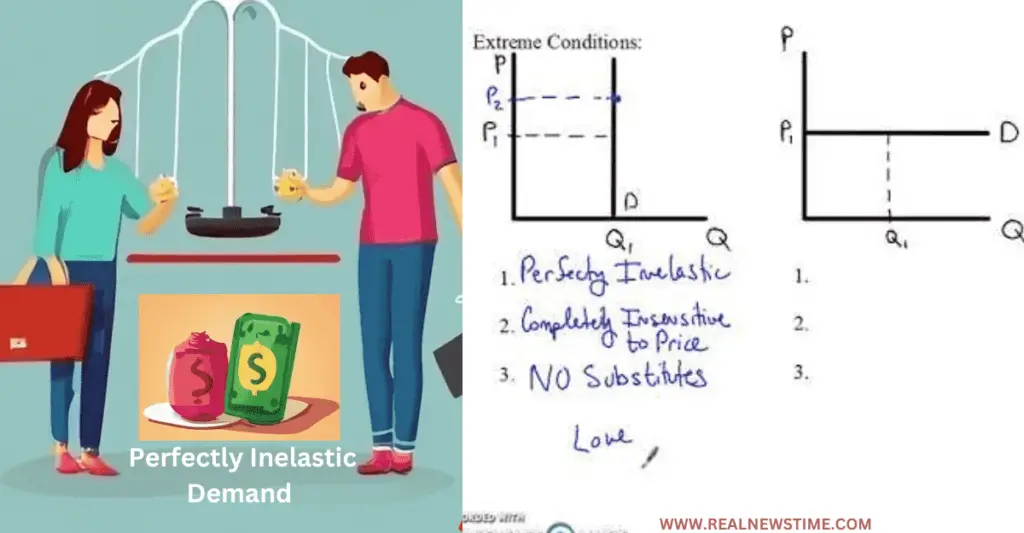Perfectly inelastic demand is a fascinating concept in economics, representing a scenario where the quantity demanded remains constant regardless of price changes. In this article, we will explore the characteristics, real-world examples, influencing factors, and various aspects related to perfectly inelastic demand.

I. Introduction
Definition of Perfectly Inelastic Demand
Perfectly inelastic demand refers to a situation in which the quantity demanded for a product or service remains constant, regardless of any change in its price. Unlike other types of demand elasticity, perfectly inelastic demand indicates a complete lack of responsiveness to price fluctuations.
Importance in Economics
II. Characteristics of Perfectly Inelastic Demand
Zero Elasticity
The key characteristic of inelastic demand is zero elasticity. Indicates that the quantity demanded remains unchanged, regardless of any fluctuations in the price. In simpler terms, consumers are entirely unresponsive to price changes.
Vertical Demand Curve
Graphically, inelastic demand is represented by a vertical demand curve. This visual representation emphasizes the constant quantity demanded at every possible price level. The vertical curve distinguishes perfectly inelastic demand from other types of demand elasticity.
III. Real-world Examples
Life-saving Medications
One of the most common examples of inelastic demand is found in life-saving medications. Individuals requiring specific drugs to sustain their lives are often willing to pay any price, and their demand remains unaffected by changes in the cost of the medication.
Niche Luxury Goods
Certain niche luxury goods, such as limited edition collectibles or bespoke items, may also exhibit perfectly inelastic demand. Consumers who seek exclusivity and uniqueness may be willing to pay premium prices, irrespective of any fluctuations in the market.
IV. Factors Influencing Perfectly Inelastic Demand
Lack of Substitutes
inelastic demand is often associated with products or services that lack substitutes. When no alternative is available, consumers have no choice but to continue purchasing the item at any given price.
Short-run Perspective
inelastic demand is more likely to occur in the short run, where consumers face urgent needs or limited options. Over time, market dynamics may evolve, leading to changes in demand elasticity.
V. Pricing Strategies
Monopoly Influence
Monopolies, with exclusive control over the supply of certain goods or services, can capitalize on perfectly inelastic demand. This allows them to set high prices without fear of losing customers, maximizing their revenue.
Impact on Market Dynamics
The presence of inelastic demand can significantly impact overall market dynamics. It may lead to distortions in pricing mechanisms and create challenges for businesses operating in such conditions.
VI. Challenges and Criticisms
Consumer Dissatisfaction
While businesses may benefit from stable demand, consumers may face dissatisfaction due to high prices. This can result in public outcry, ethical concerns, and potential regulatory interventions.
Market Inefficiencies
inelastic demand can contribute to market inefficiencies, as it disrupts the natural balance of supply and demand. This may lead to resource misallocations and hinder the overall economic welfare.
VII. Benefits and Drawbacks for Businesses
Revenue Stability
For businesses dealing with products characterized by inelastic demand, revenue stability is a significant advantage. The predictability of demand allows for strategic planning and financial forecasting.
Limited Market Growth
On the flip side, businesses operating in markets with inelastic demand may face challenges in expanding their customer base. The limited potential for market growth can be a drawback in the long run.
VIII. Case Study: Healthcare Industry
Prescription Medications

The healthcare industry often experiences perfectly inelastic demand for certain prescription medications. Patients, in need of specific drugs for treatment, are willing to pay high prices to ensure their well-being, creating a complex ethical and economic landscape.
Pricing Controversies
High drug prices and pricing controversies in the pharmaceutical sector highlight the challenges associated with perfectly inelastic demand. Balancing the need for innovation and accessibility becomes a delicate task for industry players.
IX. Adapting to Market Changes
Innovation in Product Offerings
Businesses facing inelastic demand should focus on continuous innovation in product offerings. This can involve introducing complementary products or enhancing existing ones to attract a broader customer base.
Regulatory Interventions
To address ethical concerns and ensure fair market practices, regulatory interventions may be necessary. Governments may need to step in to prevent exploitation of consumers and maintain a balance between profitability and societal welfare.
X. Future Trends
Technological Advancements
As technology continues to advance, the landscape of perfectly inelastic demand may change. Innovations in healthcare, for example, could lead to the development of more affordable alternatives, altering the dynamics of demand elasticity.
Shifts in Consumer Behavior
Changes in consumer preferences and behavior can also influence perfectly inelastic demand. Businesses must stay attuned to evolving market trends and adapt their strategies accordingly to remain competitive.
XI. Conclusion
In conclusion, perfectly inelastic demand is a concept that plays a vital role in understanding market behavior and pricing dynamics. While it offers benefits in terms of revenue stability, it comes with challenges related to consumer satisfaction and market inefficiencies. Businesses must navigate this economic phenomenon carefully, considering both ethical and strategic implications.
XII. Frequently Asked Questions
Is Perfectly Inelastic Demand Common?
Perfectly inelastic demand is relatively rare but can be observed in specific industries where essential goods or services lack substitutes.
Can Businesses Benefit from Perfectly Inelastic Demand in the Long Term?
While businesses can enjoy revenue stability in the short term, the lack of market growth potential may pose challenges for sustained success in the long run.
How Does Perfectly Inelastic Demand Affect Pricing Strategies?
Businesses with perfectly inelastic demand can adopt pricing strategies that maximize revenue, often setting higher prices without fear of losing customers.
